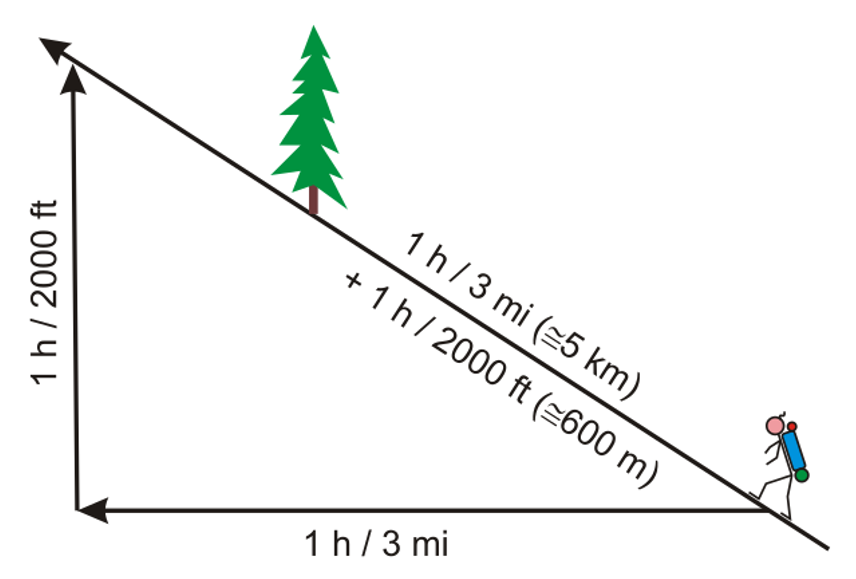DofE Expedition Training Resources for individuals Schools & Groups
While we are not able to get outside to walk or even get together in groups to plan, using a map and Niasmith’s rule is a great way to occupy your mind and learn a useful navigation skill. All you need is a route card ( https://www.mountain-water.co.uk/dofe-resources-route-cards/ ), this blog and a 1:25 000 or 1:50 000 map to practice this route planning skill. #Covid19, #staysafe, #stayhome
What is Naismith’s Rule?

Naismith’s Rule is a formula that can be used when planning a hill route to work out roughly how long it ought to take. Devised in 1892 by the Victorian mountaineer William Naismith, this well-known rule of thumb remains in common use today with only minor revisions.
The basic rule allows:
- One hour for every 5km walked on the flat
- Plus one hour per 600m ascent (which conveniently breaks down to 10mins per 100m or 1min per 10m)
Worked Example one:
Therefore a walk of 7.5km with 200m ascent would be 1 hour 30minutes for the distance, plus 20 minutes for the ascent = 1 hour 50 minutes
Worked Example two:
A walk of 5km with 150m ascent would be 1 hour for the distance, plus an extra 15 minutes for the ascent = 1 hour 15 minutes
Sound simple? Well sadly in practice it does tend to prove too simple to be true.
First off it should be noted that these are ideal timings on paper, and that your actual on-the-ground time is likely to be subject to real world delays, factors that you need to make some attempt to account for when plotting each leg of your journey.
Naismith’s Rule assumes that you are reasonably fit, walking on easy terrain, and not subject to adverse weather. It takes no heed of the slowing influence of heavy loads, fatigue, rest stops, delays caused by tricky navigation – in poor visibility perhaps, adverse weather such as a strong headwind, or the ground underfoot.
Add bogs, scree, undergrowth, snow, steep gradients (both going up and going down), a heavy pack, some basic scrambling, a crosswind, a group of mixed abilities, and the obligatory photo stops to the mix and your confident Naismith timings are likely to look a little ambitious.
Stretched over a long hilly day that tireless 5km per hour is quite some pace, and unless you are a hill runner it is very much the minimum time, not the average!
In practise then, Naismith’s Rule should be treated just as the starting point – albeit a very useful one – for working out your timings.
Every walk is different, and so is every walker. But by starting with Naismith’s Rule as a basis you should with experience be able to work out your own rough averages.
The table below should hopefully help you with your planning when working on different speeds:
| Distance travelled | Speed kilometres per hour | |||
| Metres | 5 | 4 | 3 | 2 |
| 1,000m | 12 min | 15 min | 20 min | 30 min |
| 900m | 11 min | 13 1/2 min | 18 min | 27 min |
| 800m | 9 1/2 min | 12 min | 16 min | 24 min |
| 700m | 8 1/2 min | 10 1/2 min | 14 min | 21 min |
| 600m | 7 min | 9 min | 12 min | 18 min |
| 500m | 6 min | 7 1/2 min | 10 min | 15 min |
| 400m | 5 min | 6 min | 8 min | 12 min |
| 300m | 3 1/2 min | 4 1/2 min | 6 min | 9 min |
| 200m | 2 1/2 min | 3 min | 4 min | 6 min |
| 100m | 1 min | 1 1/2 min | 2 min | 3 min |
| 50m | 1/2 min | 3/4 min | 1 min | 1 1/2 min |
The timings are rounded to the nearest ½ minute.
Add 1 minute per 10 metres of ascent
Mountain Water Expeditions is a DofE Approved Activity (AAP) for the Expedition section at all three levels of the award and also the DofE residential section at gold level.
We have over thirty years of experience of working with schools, colleges and other community-based groups providing DofE expeditions of all levels in the UK and overseas.
Mountain Water Expeditions has undergone external inspections from all the relevant authorities and has been successful in gaining an AALA license, DofE AAP licences for expeditions and the residential section and we hold the Learning Outside the Classroom Quality badge.
We are also approved to run leadership award coach education courses from British Canoeing and leadership training and assessment courses from Mountain Training. We also provide first aid training under the umbrella of Rescue and Emergency Care (REC).
